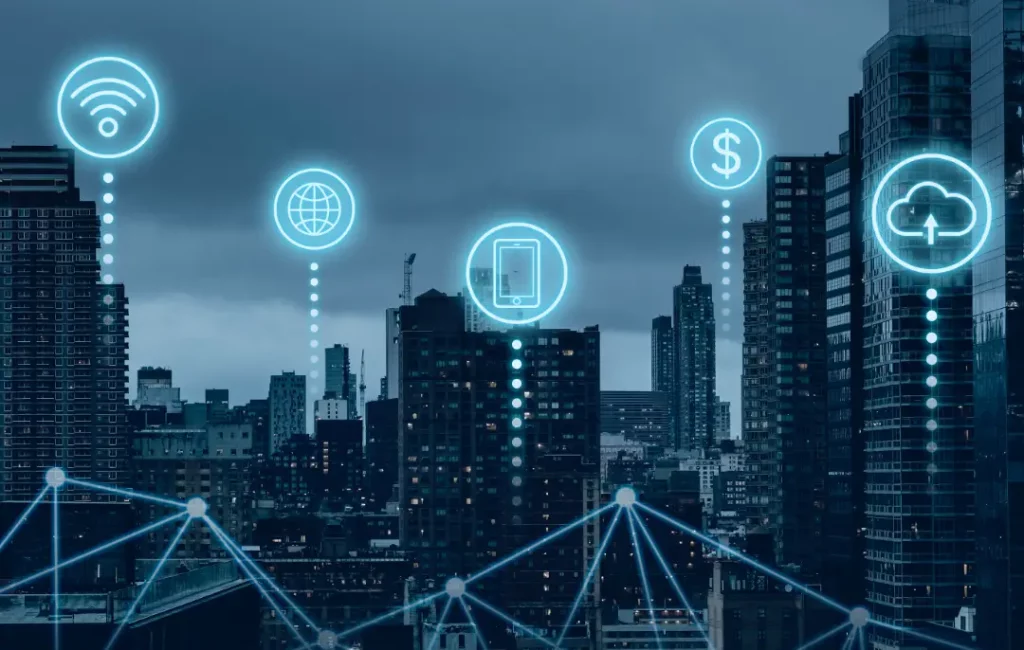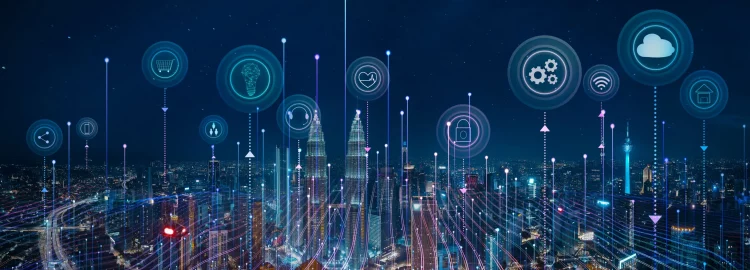As technology continues to evolve, especially with the rapid growth of 5G and the Internet of Things (IoT), electric vehicles (EVs) are gradually transitioning from mere energy conversion tools to intelligent mobility platforms. With the combination of these two emerging technologies, electric vehicles of the future will no longer be just a mode of transportation but will become a central part of an efficient, smart mobility ecosystem. This article will explore how the integration of 5G and IoT can transform electric vehicles into true smart mobility platforms and analyze how this transformation will impact the future of transportation, urban infrastructure, and user experience.
1. The Relationship Between Electric Vehicles and Smart Mobility Platforms
The rise of electric vehicles represents a significant step toward sustainable and green transportation. However, EVs alone are just the first step. For them to become genuine smart mobility platforms, they need to leverage advancements in technology, particularly 5G and IoT.
A smart mobility platform goes beyond just the electric vehicle; it includes real-time interaction with the environment, traffic systems, and other devices. By being connected to the internet, electric vehicles can seamlessly communicate with traffic lights, road sensors, other vehicles, and even home devices, creating a more efficient, safe, and convenient transportation experience.
2. The Role of 5G in Advancing Electric Vehicle Intelligence
2.1 5G Networks: Ultra-Low Latency and High-Speed Data Transfer
The defining features of 5G technology include ultra-low latency and incredibly high-speed data transfer. These features are crucial for enabling electric vehicles to function as part of a real-time, intelligent transportation network.
- Ultra-Low Latency: 5G’s ability to minimize latency (the delay in transmitting data) is particularly important for applications that require real-time decision-making, such as autonomous driving, vehicle-to-vehicle (V2V) communication, and vehicle-to-infrastructure (V2I) interactions. With 5G, EVs will be able to instantly communicate with traffic signals, other vehicles, and road infrastructure, allowing for smoother, safer travel.
- High-Speed Data Transfer: The ability to transmit large amounts of data at high speeds allows for more detailed and frequent updates from various sensors and systems within the vehicle. For example, electric vehicles equipped with advanced driver-assistance systems (ADAS) will be able to process data from cameras, radar, and lidar in real time, providing enhanced safety features such as collision avoidance and adaptive cruise control.
5G networks will enable EVs to access cloud-based services seamlessly, providing real-time traffic information, weather updates, and even personalized driving recommendations.
2.2 Enabling Autonomous Driving
5G is set to play a pivotal role in the development of autonomous driving. Autonomous vehicles rely on constant communication with their environment to make decisions. With 5G, EVs can connect to various external networks and sensors to enhance their decision-making capabilities. This can include:
- V2X (Vehicle-to-Everything) Communication: Through V2X, electric vehicles can communicate not only with other vehicles but also with infrastructure like traffic lights, road signs, and pedestrian systems, allowing them to adapt their behavior to the road conditions in real time.
- Enhanced Safety: With 5G, EVs will be able to react almost instantaneously to sudden events, such as a vehicle cutting into their lane or pedestrians crossing the road. This reduces the likelihood of accidents and enhances overall traffic flow.
3. How IoT is Enhancing Electric Vehicle Intelligence
3.1 Vehicle-to-Vehicle (V2V) and Vehicle-to-Infrastructure (V2I) Communication
The IoT involves connecting everyday devices to the internet to collect and share data. In the context of electric vehicles, IoT enables vehicles to communicate with each other and the surrounding infrastructure. This facilitates intelligent transportation systems that can manage traffic in real-time, reducing congestion and optimizing route planning.
- V2V Communication: Electric vehicles equipped with IoT sensors can communicate with each other to share information about road conditions, traffic congestion, or even potential hazards like accidents. This shared information can help optimize driving behavior, prevent collisions, and reduce travel times.
- V2I Communication: Vehicles can also connect to infrastructure elements such as traffic lights, toll booths, and parking meters. For example, traffic signals could be adjusted in real-time based on the number of vehicles approaching an intersection, reducing wait times and improving traffic flow.
3.2 Smart Charging and Battery Management
IoT can also enable smarter charging solutions for electric vehicles. Through IoT-enabled systems, EVs can be connected to smart grids, allowing them to charge when electricity is cheapest or when there is less demand on the grid. This not only helps to optimize energy use but also supports the grid’s efficiency.
- Smart Charging Stations: IoT-enabled charging stations can provide real-time updates to users about the availability of charging points, wait times, and the charging status of their vehicle.
- Battery Health Monitoring: IoT systems can continuously monitor the health and performance of the EV’s battery. This data can be sent to the manufacturer or service provider for predictive maintenance, ensuring that the battery is always operating at peak efficiency.

4. The Integration of 5G and IoT: A True Smart Mobility Platform
4.1 Seamless Connectivity and Data Exchange
When combined, 5G and IoT will enable electric vehicles to become integral parts of a larger, connected transportation ecosystem. These vehicles will not only communicate with each other but also with public transportation systems, urban infrastructure, and even personal devices such as smartphones. This creates a truly smart mobility platform where data flows seamlessly between all participants in the system, optimizing traffic, safety, and user experience.
- Smart Cities: The integration of EVs, 5G, and IoT will help create smart cities where transportation systems are not only efficient but also sustainable. EVs will be able to communicate with smart traffic management systems to ensure optimal routing and efficient energy use.
- Personalized User Experience: EVs, through IoT and 5G, can learn from a user’s driving habits, preferences, and even emotional states. With this data, the vehicle can adjust driving modes, cabin conditions, and entertainment options to create a personalized driving experience.
4.2 Autonomous Fleets and Shared Mobility
As electric vehicles become more integrated with 5G and IoT, we may see the emergence of autonomous EV fleets that offer shared mobility services. These fleets will be able to operate without human drivers, offering users the flexibility to use electric vehicles on-demand without the need for ownership.
- On-Demand Mobility: EVs could become part of an on-demand transportation service, where users can book a ride, and an autonomous electric vehicle will arrive to pick them up. The vehicles will be able to communicate with the system to optimize the routes, ensuring the fastest and most efficient trips.
- Fleet Management: IoT and 5G will enable fleet managers to monitor the status of each vehicle in real-time, including location, battery charge, and maintenance needs. This will improve fleet efficiency and reduce downtime.
5. Challenges and Considerations
While the integration of 5G and IoT into electric vehicles offers tremendous potential, several challenges need to be addressed:
- Data Privacy and Security: As vehicles become more connected, they will generate massive amounts of data. Ensuring the privacy and security of this data is crucial to prevent hacking and unauthorized access to personal information.
- Infrastructure Requirements: For smart mobility platforms to be fully realized, urban infrastructure must also be upgraded. This includes the installation of IoT sensors, 5G networks, and smart charging stations across cities.
- Regulatory Hurdles: Governments will need to implement regulations to ensure the safety and efficiency of autonomous electric vehicles and connected transportation systems.
6. Conclusion: A Future of Smart, Connected Electric Vehicles
The integration of 5G and IoT has the potential to revolutionize the electric vehicle industry, turning EVs into true smart mobility platforms. Through real-time communication with other vehicles, infrastructure, and the cloud, electric vehicles will be able to offer a safer, more efficient, and personalized transportation experience. The combination of these technologies will pave the way for autonomous fleets, on-demand mobility, and smart cities, transforming how we live and travel.
However, the full realization of this vision will require overcoming significant challenges in terms of infrastructure, security, and regulation. As these obstacles are addressed, the future of transportation will undoubtedly be smarter, greener, and more connected, with electric vehicles at the heart of this transformation.











































